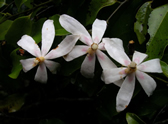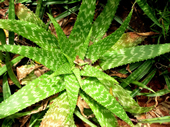Global: Over 12,000 plants on the red list
03.10.09
It’s that dreaded time of year again - the time when it is spelled out so clearly how badly we are failing the planet. The latest update of the IUCN Red List of Threatened Species shows that 17,291 species out of the 47,677 assessed species are threatened with extinction. Of these a staggering 12,151 are plants - up 96 on last year - but it’s almost guaranteed they will get less publicity than their furry friends.
But it’s not just plants that under threat: there is worrying news across the board as the results show 21 per cent of mammals, 30 per cent of amphibians, 12 per cent of birds, 28 per cent of reptiles, 37 percent of freshwater fishes, 70 percent of plants, and 35 percent of invertebrates assessed so far are under threat. “This year’s IUCN Red List makes for sobering reading,” says Craig Hilton-Taylor, Manager of the IUCN Red List Unit. “These results are just the tip of the iceberg. There are many more millions out there which could be under serious threat. We do, however, know from experience that conservation action works so let’s not wait until it’s too late and start saving our species now.”
Of the plants on the list that no species wants to be on, 8,500 are threatened with extinction and 114 are already Extinct or Extinct in the Wild.
Queen of the Andes © Antonio Lambe
Take the case of the Queen of the Andes (Puya raimondii). This spectacular plant occurs in the Andes of Peru and Bolivia. Its populations are often very isolated from each other. Thanks to a single enormous subpopulation, which could represent most of the world’s population of this plant, the population size may number 800,000 individuals. Bolivia is estimated to have 30,000-35,000 plants. This species produces seeds only once in about 80 years or more before dying, and although a mature plant will produce 8 – 12 million seeds, inclement montane conditions at the time of dispersal, which may also affect pollinating insects, can result in few if any germinations. Moreover, seeds in less than ideal conditions can begin to lose germinating ability after a few months and are also susceptible to damping-off. Because of these factors, a century-old plant may not reproduce at all and will, botanically, have lived in vain. This risk is exacerbated by global warming whose effects on Peru’s glaciers are well established and climate change may already be impairing Puya raimondii’s ability to flower.
In some areas, cattle roam freely among many colonies, which as a result are not being regenerated because the animals either trample or may eat young plants. In other sites, fires are set to create pastureland or the thorny leaves are burnt to facilitate access to the trunks' starch which becomes cattle fodder. Pith removal, of course, kills the plant. Compounding all these issues, there is very little genetic variety within existing populations, indicating a lack of mixing between different populations, resulting in inbreeding. Even though fully fitted to its harsh environment, P. raimondii lacks sufficient variability in its genome to allow it to adapt to both human pressure and changing climate.
“The scientific evidence of a serious extinction crisis is mounting,” says Jane Smart, Director of IUCN’s Biodiversity Conservation Group. “January sees the launch of the International Year of Biodiversity. The latest analysis of the IUCN Red List shows the 2010 target to reduce biodiversity loss will not be met. It’s time for governments to start getting serious about saving species and make sure it’s high on their agendas for next year, as we’re rapidly running out of time.”
Other stories from the List
Toussaintia orientalis
 Toussaintia orientalis is a small tree found in dry evergreen lowland forest and bushland in Tanzania and Kenya, although the only known site in Kenya (Mangea) may now be destroyed. At Mangea most if not all of the forest has gone because of agricultural expansion. In Tanzania, there is intensive agriculture in Ifakara and the species may also have now disappeared from that locality. The Pugu Forest Reserve has also been badly impacted by human activities, however the species is better protected in the other forest reserves where it occurs.
Toussaintia orientalis is a small tree found in dry evergreen lowland forest and bushland in Tanzania and Kenya, although the only known site in Kenya (Mangea) may now be destroyed. At Mangea most if not all of the forest has gone because of agricultural expansion. In Tanzania, there is intensive agriculture in Ifakara and the species may also have now disappeared from that locality. The Pugu Forest Reserve has also been badly impacted by human activities, however the species is better protected in the other forest reserves where it occurs.
© Quentin Luke
Aloe kilifiensis - EN
 Aloe kilifiensis is an Endangered species that occurs along the southern Kenyan coast. It was also discovered more recently on the northern Tanzanian coast. This succulent plants grows in Acacia bushland on shale soils, on coral rocks and on white gritty soils. It is locally common in places, however there is considerable habitat disturbance in its range due to agricultural expansion and other human activities in this coastal zone. The species is also sought after by succulent collectors because of the striking flower colour.
Aloe kilifiensis is an Endangered species that occurs along the southern Kenyan coast. It was also discovered more recently on the northern Tanzanian coast. This succulent plants grows in Acacia bushland on shale soils, on coral rocks and on white gritty soils. It is locally common in places, however there is considerable habitat disturbance in its range due to agricultural expansion and other human activities in this coastal zone. The species is also sought after by succulent collectors because of the striking flower colour.
© Quentin Luke
Related links: